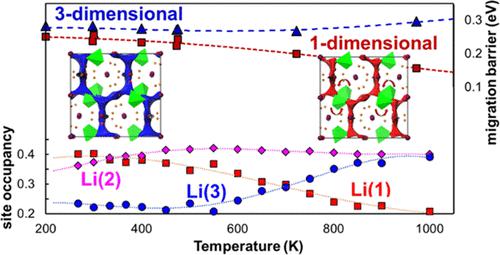当前位置:
X-MOL 学术
›
Chem. Mater.
›
论文详情
Our official English website, www.x-mol.net, welcomes your
feedback! (Note: you will need to create a separate account there.)
Temperature Dependence of Structure and Ionic Conductivity of LiTa2PO8 Ceramics
Chemistry of Materials ( IF 7.2 ) Pub Date : 2022-11-30 , DOI: 10.1021/acs.chemmater.2c02640 Ruoyu Dai 1 , Maxim Avdeev 2, 3 , Seung-Joo Kim 4 , Rayavarapu Prasada Rao 5 , Stefan Adams 1
Chemistry of Materials ( IF 7.2 ) Pub Date : 2022-11-30 , DOI: 10.1021/acs.chemmater.2c02640 Ruoyu Dai 1 , Maxim Avdeev 2, 3 , Seung-Joo Kim 4 , Rayavarapu Prasada Rao 5 , Stefan Adams 1
Affiliation

|
LiTa2PO8 has recently been reported as a new fast Li-ion conducting structure type within the series of Lix(MO6/2)m(TO4/2)n polyanion oxides. Here, we demonstrate the preparation of LiTa2PO8 by solid-state syntheses, clarify the temperature dependence of lithium distribution and ionic conductivity, and study the structural stability, densification, and achievable total conductivity as a function of sintering conditions synergizing experimental neutron and X-ray powder diffraction and electrochemical studies with computational energy landscape analyses and molecular dynamics simulations. A total room temperature conductivity of 0.7 mS cm–1 with an activation energy of 0.27 eV is achieved after sintering at 1323 K for 10 h. Spark plasma sintering yields high densification >98%, highly reproducible bulk conductivities of 2.8 mS cm–1, in agreement with our bond valence site energy-based pathway predictions, and total conductivities of 0.6 mS cm–1 within minutes. Powder diffraction studies from 3 to 1273 K reveal a reversible flipping of the monoclinic angle from above to below 90° close to room temperature as a consequence of rearrangements of the mobile ions that change the detailed pathway topology. A consistent model of the temperature-dependent Li redistribution, conductivity anisotropy, and transport mechanism is derived from a synopsis of diffraction experiments, experimental conductivity studies, and simulations. Due to the limited electrochemical window of Lix(TaO6/2)2(PO4/2)1 (LTPO), a direct contact with Li metal or high voltage cathode materials leads to degradation, but as demonstrated in this work, semi-solid-state batteries, where LTPO is protected from direct contact with lithium by organic buffer layers, achieve stable cycling.
中文翻译:

LiTa2PO8 陶瓷结构和离子电导率的温度依赖性
LiTa 2 PO 8最近被报道为Li x (MO 6/2 ) m (TO 4/2 ) n聚阴离子氧化物系列中的新型快速锂离子传导结构类型。在这里,我们演示了 LiTa 2 PO 8的制备通过固态合成,阐明锂分布和离子电导率的温度依赖性,并研究结构稳定性、致密化和可实现的总电导率作为烧结条件的函数协同实验中子和 X 射线粉末衍射和电化学研究与计算能量景观分析和分子动力学模拟。在 1323 K 下烧结 10 小时后,室温总电导率为 0.7 mS cm –1,活化能为 0.27 eV。放电等离子烧结产生高致密化 >98%,高度可重现的体积电导率为 2.8 mS cm –1,与我们基于键价位点能量的路径预测一致,总电导率为 0.6 mS cm –1几分钟内。从 3 到 1273 K 的粉末衍射研究表明,由于移动离子的重排改变了详细的通路拓扑结构,单斜角在接近室温时从 90° 以上到以下可逆翻转。依赖于温度的 Li 再分布、电导率各向异性和传输机制的一致模型源自衍射实验、实验电导率研究和模拟的概要。由于Li x (TaO 6/2 ) 2 (PO 4/2 ) 1的电化学窗口有限(LTPO),与锂金属或高压阴极材料直接接触会导致降解,但正如这项工作所证明的那样,半固态电池通过有机缓冲层保护 LTPO 不与锂直接接触,实现稳定循环.
更新日期:2022-11-30
中文翻译:

LiTa2PO8 陶瓷结构和离子电导率的温度依赖性
LiTa 2 PO 8最近被报道为Li x (MO 6/2 ) m (TO 4/2 ) n聚阴离子氧化物系列中的新型快速锂离子传导结构类型。在这里,我们演示了 LiTa 2 PO 8的制备通过固态合成,阐明锂分布和离子电导率的温度依赖性,并研究结构稳定性、致密化和可实现的总电导率作为烧结条件的函数协同实验中子和 X 射线粉末衍射和电化学研究与计算能量景观分析和分子动力学模拟。在 1323 K 下烧结 10 小时后,室温总电导率为 0.7 mS cm –1,活化能为 0.27 eV。放电等离子烧结产生高致密化 >98%,高度可重现的体积电导率为 2.8 mS cm –1,与我们基于键价位点能量的路径预测一致,总电导率为 0.6 mS cm –1几分钟内。从 3 到 1273 K 的粉末衍射研究表明,由于移动离子的重排改变了详细的通路拓扑结构,单斜角在接近室温时从 90° 以上到以下可逆翻转。依赖于温度的 Li 再分布、电导率各向异性和传输机制的一致模型源自衍射实验、实验电导率研究和模拟的概要。由于Li x (TaO 6/2 ) 2 (PO 4/2 ) 1的电化学窗口有限(LTPO),与锂金属或高压阴极材料直接接触会导致降解,但正如这项工作所证明的那样,半固态电池通过有机缓冲层保护 LTPO 不与锂直接接触,实现稳定循环.











































 京公网安备 11010802027423号
京公网安备 11010802027423号